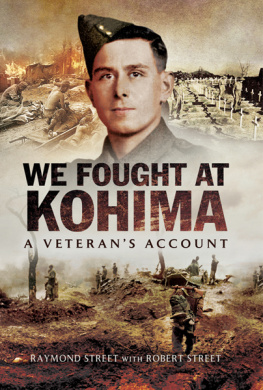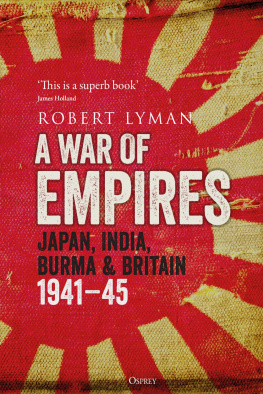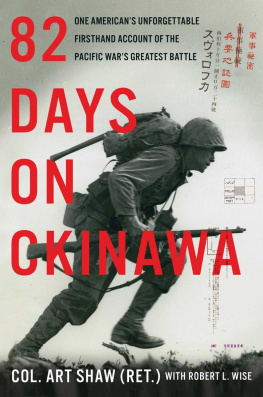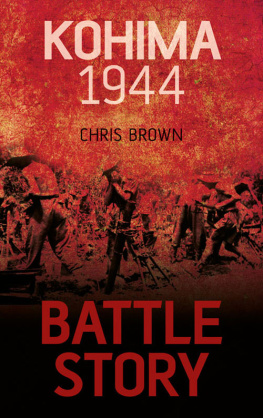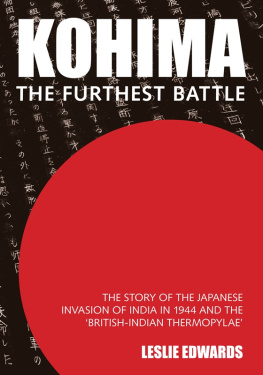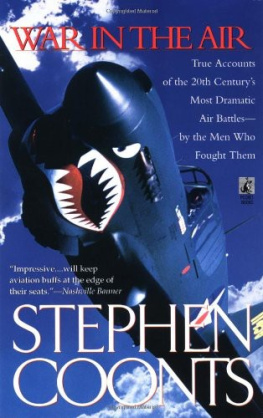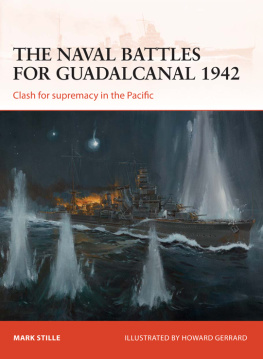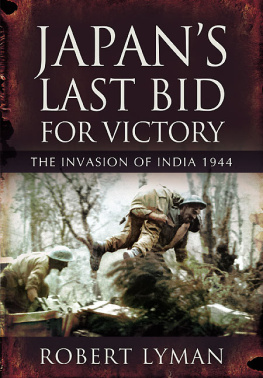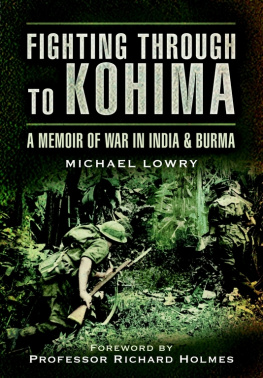First published in Great Britain by
PEN AND SWORD MILITARY
an imprint of
Pen and Sword Books Ltd
47 Church Street
Barnsley
South Yorkshire S70 2AS
Copyright Raymond Street with Robert Street, 2015
ISBN: 978 1 47384 367 7
PDF ISBN: 978 1 47386 386 6
EPUB ISBN: 978 1 47386 385 9
PRC ISBN: 978 1 47386 384 2
The right of Raymond Street with Robert Street to be identified as the authors of this work has been asserted by them in accordance with the Copyright, Designs and Patents Act 1988.
A CIP record for this book is available from the British Library.
All rights reserved. No part of this book may be reproduced or transmitted in any form or by any means, electronic or mechanical including photocopying, recording or by any information storage and retrieval system, without permission from the Publisher in writing.
Printed and bound in England by
CPI Group (UK) Ltd, Croydon, CR0 4YY
Typeset in Times by CHIC GRAPHICS
Pen & Sword Books Ltd incorporates the imprints of
Archaeology, Atlas, Aviation, Battleground, Discovery, Family History, History, Maritime, Military, Naval, Politics, Railways, Select, Social History, Transport, True Crime, Claymore Press, Frontline Books, Leo Cooper, Praetorian Press, Remember When, Seaforth Publishing and Wharncliffe.
For a complete list of Pen and Sword titles please contact
Pen and Sword Books Limited
47 Church Street, Barnsley, South Yorkshire, S70 2AS, England
E-mail:
Website: www.pen-and-sword.co.uk
Contents
Preface
What did Granddad do in the War? Many children ask that nowadays. Many parents do not know. Some never found out, because the suffering and the horrors they experienced prevented men talking about their war years. In some cases the details have been taken to their graves. It was the norm to sweep such things under the carpet. I remember my father, Raymond Street, was told on numerous occasions not to go on about the war. It almost became a forbidden subject. Fortunately, my childrens grandfather did go on, and his story was published in 1998 in a book called A Brummie in Burma. It told of his experiences as a typical inner city lad thrust into the amazing sights of exotic foreign lands and into the horrors of war. It chronicled the activities and achievements of his regiment, the 4th Battalion of the Queens Own Royal West Kents, in India and Burma, including its remarkable defence during the siege of Kohima, where a possible Japanese advance to India was halted.
Subsequent to the publication of that book, many former Royal West Kents contacted me with previously unknown information about the battle, some of which had not even been disclosed to their family or friends. Since then I have researched the siege and taken accounts from those who were there. Unfortunately, memories have sometimes faded, but often they are still vivid.
The present book, whilst dealing with a much wider time period, describes in detail the experiences of the 4th Battalion of the Queens Own Royal West Kent Regiment during the siege and defence of Kohima. It tells of personal experiences and the individual thoughts of the men as some 446 West Kents, together with the supporting Assam Regiment and Assam Rifles, held nearly 15,000 Japanese soldiers at bay for sixteen days until relief arrived. Although this was one of the most important land battles of the Second World War, a major turning point in favour of the Allies, it went somewhat unnoticed in the bigger picture. Indeed, those involved in Kohima and the subsequent advance into Burma have become known as the Forgotten Army. Well, many of those involved have told me that they refuse to be forgotten and have freely given me details of their experiences so that the truth may be known once and for all. Their story is told by me in the form of a first-person account by my father, Raymond Street, who even today has vivid memories of that time, and it gives a detailed account of day-to-day events. The story may be disjointed in parts, where recollections of exact events are sometimes unclear, but it has been left this way deliberately, since to resort to invention would detract from these mens achievements.
AT KOHIMA IN APRIL 1944, THE JAPANESE
INVASION OF INDIA WAS HALTED
These words are inscribed on the 161st Brigade memorial at Kohima. This was a small garrison town in Nagaland near the Indo-Burmese border. It was a supply depot and convalescent camp on the main road between Imphal and Dimapur, where the British had set up command posts and supply bases. If the Japanese had taken these two towns they would have opened a gateway to invade India; and once they had possession of the associated airstrips and railheads they might have been impossible to stop. Attacks on Imphal and Dimapur were therefore expected, but to get to Dimapur through Kohima, the enemy would have to bring their army over inhospitable, mountainous jungle terrain. The British military authorities did not think this possible. However, despite the jungle conditions and disease, the Japanese did bring over 15,000 men together with their equipment, living off the land and capturing provisions as they went. They headed for Dimapur, but first they had to take Kohima, garrisoned at that time by the Indian Assam Regiment and the 3rd Assam Rifles. At the end of March 1944, the 4th Battalion of the Queens Own Royal West Kent regiment was sent to help. Just 446 officers and men arrived on 5 April 1944, to fight at Kohima while it was under siege, until relief came on 20 April 1944. Not many of these left the battlefield unaided. My father, Raymond Street, and some of the other survivors were kind enough to share their experiences with me. This is their story and is dedicated to those who did not return.
Robert Street
May 2013
Chapter 1
Early Days
I couldnt have been more than four or five. I was in a large room with a billiard table. We were at the house sale of some former high ranking military officer who had died. It was also a gunroom. My parents were there to see what they could buy for the second-hand furniture shop they ran. My father was going through my pockets taking away some live bullets that Id got hold of and giving my mother a dressing down for not keeping an eye on me. Id always had a fascination for guns and couldnt wait until I could buy my first air rifle.
We lived above a shop in Montpelier Villas, Cheltenham, later moving to the house at the rear. Early one morning, my mother woke me up. She said that we had to go and catch the train to Birmingham and that my father would follow later with the furniture. We were always moving around. My mother would set up in business, only to move on again when it failed or trade was so poor she couldnt go on. In Cheltenham trade was bad. It was time for a new start. We had relatives in Birmingham, so that was where we went.
In 1931 the country was still in the depths of the Depression. Being out of work was a way of life. My mother Ivy was the breadwinner, buying and selling second-hand furniture, paintings or whatever she could in her shop. She was a slim raven-haired woman with blue eyes, somewhat Jewish in appearance, which matched her business acumen. She married my father Arthur in 1917, shortly after he was invalided out of the First World War, wounded by a Turkish snipers bullet. It ripped out most of his throat, damaging his vocal cords and leaving him with a hoarse, gravelly voice. He was a regular soldier, but had no trade or profession when he left the Army. He was only able to do casual work. Jobs were at a premium, so he was out of work most of the time. He had to sell his war medals and treasured collection of butterflies, caught during his days in India, to provide for us. His Army pension was only 1 per week. Mom earned what she could, but we never had enough.
Next page
